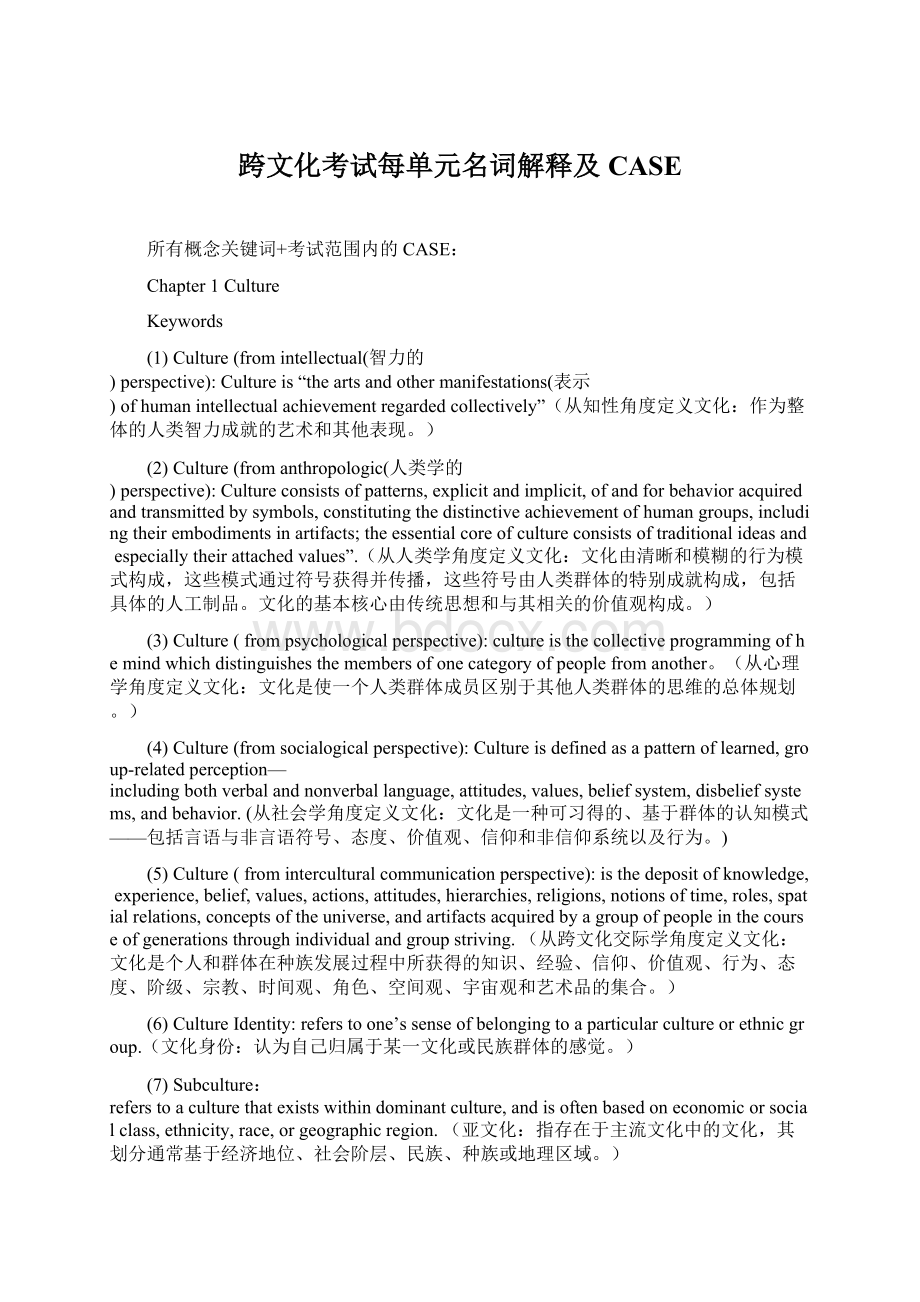跨文化考试每单元名词解释及CASEWord文件下载.docx
《跨文化考试每单元名词解释及CASEWord文件下载.docx》由会员分享,可在线阅读,更多相关《跨文化考试每单元名词解释及CASEWord文件下载.docx(11页珍藏版)》请在冰豆网上搜索。

which
distinguishes
members
one
category
people
another。
(从心理学角度定义文化:
文化是使一个人类群体成员区别于其他人类群体的思维的总体规划。
)
(4)
socialogical
defined
as
a
pattern
learned,
group-related
perception—including
both
verbal
nonverbal
language,
attitudes,
values,
belief
system,
disbelief
systems,
behavior.
(从社会学角度定义文化:
文化是一种可习得的、基于群体的认知模式——包括言语与非言语符号、态度、价值观、信仰和非信仰系统以及行为。
(5)
intercultural
communication
deposit
knowledge,
experience,
belief,
actions,
hierarchies,
religions,
notions
time,
roles,
spatial
relations,
concepts
universe,
artifacts
group
course
generations
through
individual
striving.
(从跨文化交际学角度定义文化:
文化是个人和群体在种族发展过程中所获得的知识、经验、信仰、价值观、行为、态度、阶级、宗教、时间观、角色、空间观、宇宙观和艺术品的集合。
(6)
Identity:
refers
to
one’s
sense
belonging
particular
or
ethnic
group.(文化身份:
认为自己归属于某一文化或民族群体的感觉。
(7)
Subculture:
that
exists
within
dominant
culture,
often
based
on
economic
social
class,
ethnicity,
race,
geographic
region.
(亚文化:
指存在于主流文化中的文化,其划分通常基于经济地位、社会阶层、民族、种族或地理区域。
Subcultures
exist
and
are
class,ethnicity,race,or
(8)
Co-culture:
groups
communities
exhibiting
characteristics,
perceptions,
beliefs,
practices
significantly
different
enough
distinguish
them
communities,
culture.
(共文化:
指具有独特的交际特征、感知特点、价值观、信仰和行为,区别于其他群体、社团以及主流文化的群体或社团。
(9)
Subgroup:
usually
does
not
involve
same
large
number
necessarily
thought
accumulating
values
patterns
over
way
cultures
do.
(亚群体:
相对于亚文化和共文化群体,亚群体通常规模不大,也不一定有文化群体世代相传积累的价值观念和行为模式。
Case
2:
White
Dress
analysis:
The
Indian
women
might
think
wedding
ceremony
funeral
if
they
see
western
bride
white
gown.
case
reflects
similes
metaphors
text.
like
an
iceberg:
we
can
identify
color
dress
worn
cultures,
but
do
know
underneath.
water
fish
swims
in:
wear
colors
context
take
it
granted
never
ask
why.
♣(6)
4:
Coconut-skating(用椰油保养地板的方法)
characteristics
We
tell
pervasive
it’s
learned.
People
may
invent
ways
things
even
simple
issue
floor
moping.
Philippine
woman
must
have
learned
this
mopping
her
own
2
Communication
Intercultural
Communication
Sender/Source:
A
sender/source
person
who
transmits
message.(信息发出者/信息源:
信息发出者/信息源指传递信息的人。
Message:
message
any
signal
triggers
response
receiver.(信息:
信息指引起信息接受者反应的任何信号。
Encoding:
It
activity
during
sender
choose
certain
words
methods
send
intentional
message.
(编码:
编码指信息发出者选择言语或用非言语的方式发出有目的的信息的行为。
Channel/Medium:
method
used
deliver
(渠道/媒介:
渠道/媒介指发送信息的方法。
Receiver:
receiver
notices
gives
some
meaning
(信息接受者:
信息接受者指信息接收者是指注意到信息并且赋予信息某些含义的人。
Decoding:
attaches
symbols
he/she
has
received.(解码:
解码指信息接受者赋予其收到的言语或符号信息意义的行为。
Feedback:
sender’s
called
feedback.(反馈:
反馈指信息接收者对信息源信息所做出的反应。
Noise:
term
factors
interfere
with
exchange
messages,
external
noise
physiological
noise,
semantic
noise.(干扰:
干扰指妨碍信息交流的各种因素。
包括外界干扰,生理干扰,心理干扰和语义干扰。
Context:
setting
situation
takes
place
physical
context,
interpersonal
context.(语境:
语境指交际发生的环境,包括自然语境,社会语境和人际语境。
(10)
communication:
between
whose
cultural
perception
symbol
system
distinct
alter
event.(
跨文化交际:
跨文化交际指的是那些在文化认知和符号系统上存在差异的人们之间的交际。
这些差异足以改变整个交际事件。
(11)
International
nations
governments
rather
than
individuals;
quite
formal
ritualized.
(国际交流:
国际交流是指发生在国家和政府之间而非发生在个人之间的交际;
此种交际非常正式和仪式化。
(12)
Interracial
occurs
when
exchanging
messages
races.
(跨种族交际:
跨种族交际是指交流信息的信息源和信息接受者来自不同的种族的交际。
(13)
Interethnic
among
country
culture.(跨民族交际:
跨民族交际是指来自一个国家或文化内部的不同民族群体的人们之间的交际。
(14)
Intracultural
culture.(文化内交际:
文化内交际是指同一文化内部的成员之间的交际。
(15)
:
derived
Latin
word
communicare,meaning
share
make
common,as
giving
another
part
your
thoughts,hopes,and
knowledge.
12:
Why
Don’t
You
Eat
Pizza?
This
reflect
problems
appearing
how
ignoring
differences
affect
communication.
In
Malaysia,
where
most
Muslims,
left
hand
only
cleaning
body
thus
dirty
be
pass
food.
Knowing
nothing
about
difference,
American
student
puts
himself
embarrassing
situation.
3
Culture’s
Influence
Perception
Sensation:
neurological
process
become
aware
environment.(感觉:
感觉是人们意识到周围环境的神经过程。
Perception:
objects,
events,
behaviors
our
various
senses
involves
higher-order
cognition
interpretation
sensory
information.
(知觉:
知觉是一种人们通过各种感觉来觉察事物、事件、人和人的行为的过程。
它是解释感觉信息更为高阶的认知过程。
Selection:
screen
out
what
need
all
stimuli
information
around
us.(选择:
选择是从周围选择的刺激信息中筛选出所需要的信息的过程。
Organization:
organize
impose
structure
observe
meaningful
way.
(组织:
组织是把从周围选择的刺激信息,以一种有意义的方式整理,组合的过程。
Interpretation:
attaching
data
synonymous
decoding.(释义:
释义是赋予感觉信息意义的过程,
类似于解码过程。
16:
Different
Responses
Noise
give
influences
sensation.
No
two
assume
sensations
same,
come
cultures.
reality
living
conditions
equip
world.
So
very
common
totally
towards
condition.
case,
German
professor
Japanese
produced
motor
heating
because
habits.
4
Barriers
Anxiety:
knowing
expected
do,
focusing
feeling
present
transaction.(焦虑:
当人们不知道如何迎合他人对自己的期待,过多的关注自己情绪以至不能全心投入到交际事物中去时,就会产生焦虑。
Uncertainty:
cognitive
inability
explain
other’s
feelings
interactions
ambiguous
evokes
anxiety.
(不确定:
不确定是指人们无法从认知的角度去解释交际活动中自己或他人的感觉及行为,这种认知角度解释能力的欠缺是某种引起焦虑的含糊情境导致的。
Assuming
similarity
instead
difference:
idea
coming
more
similar
you
actually
person’s
yours
fact
is.
(假定一致性:
假定一致性是指认为来自另一文化的他人和自己相似或他人的处境与自己的处境相似,而事实上却并非如此。
Ethnocentrism:
negatively
judging
aspects
standards
culture.(种族或民主中心主义:
是指从本国文化的标准出发,消极地审视另一文化。
Stereotypes:
They
refer
negative
positive
judgments
made
individuals
observable
believed
membership.(文化定势:
文化定势指基于明显的或受到认可的群体身份,对目标群体中的个体成员所持有的正面或反面的判断。
Prejudice:
irrational
dislike,
suspicion,
hatred
group,
religion,
sexual
orientation.(偏见:
偏见是指对于某一特定群体、种族、宗教、或性取向的无端地憎恶和怀疑。
Racism:
policy,
practice,
attitude
attributes
status
race.(种族主义:
种族主义是指基于种族把性格特点或地位归因于个人的任一政策、做法、信仰或态度。
21:
Danish
Woman
New
York
assuming
difference.
When
communicating
likely
regard
treat
“his
people”
there
doing
things:
way”.
D